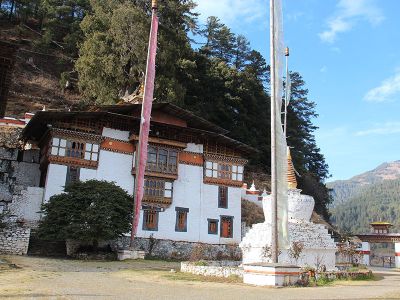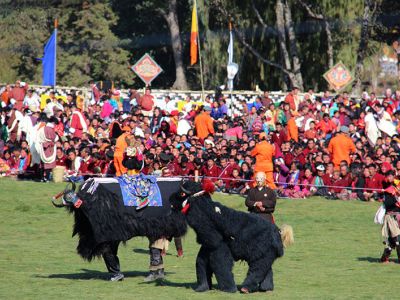Bhutan Far East
16 Nights 17 Days
This trip is designed for those who are interested in seeing a greater part of the country. The tour provides an insight into the remoteness of the country’s Far East, where development is minimal due to the high passes and terrain. Your visit will feature an authentic look at the Bhutanese lifestyle. You will see firsthand and up close how people live and work.
The East is famous for hand woven textiles, known as Khushu Thakra. Every household has a weaving loom. Weaving is usually done in winter when there is less agricultural work. Other trip highlights include the Khaling Weaving Center, school for the blind and the Kanglung College, called Sherubtse, which is currently the only University in Bhutan.
Attraction
- Views of Mount Gangkar Puensum (world’s highest unclimbed mountain) and several other Himalayan peaks, Jili Dzong (fortress) in ruins.
- Forests of fir, blue pine and dwarf rhododendrons, nomadic yak herders, pristine glacial lakes of Jigmelang, Simkotra and Janetso teeming with trouts, and the ancient monastery at Phajoding.
Detailed Itinerary
DAY 1: Paro. (2250 M)
Visit Paro Rinpung Dzong. A flagstone path rises gradually from a beautiful wooden bridge with shingle roofing and buttressed by two guardhouses of the Dzong.
Today, this massive fortress built in 1646 AD is the seat of the district administration as well as the home for the monastic school. The central tower (Utse) of the Dzong, with its superb woodwork, is one of the most beautiful in Bhutan.
DAY 2 : Hike to Tiger’s NEST (800 m from Paro valley)
Taktsang is one of the most venerated pilgrimage sites in the Himalayas. However, most people can only visit the main site called Taktsang Pel-phu. According to legend Padmasambhava founded Taktsang Monastery in the eighth century. It is believed that the Guru came to this place on the back of a tigress from Khengpajong in the Kurtoe region and meditated here for three months in a cave before converting the Paro valley to Buddhism.
DAY 3: Paro – Thimphu. (65 km. 2 hours. 2350 m)
The Dzong, although in ruins today, holds historical significance. It was from this fortress that the Bhutanese repelled many Tibetan invasions. The name means “The victorious Bhutanese”.
This spot also offers a magnificent vista of Mount Jomolhari, “Abode of the Goddess Jumo” (7315m).
On the way back you will have the pleasure of visiting one of the oldest monasteries we have in Bhutan, The first King of Tibet; Songtsen Gampo built Kichu Lhakhang in the 7th century to introduce Buddhism to our country, when our country was still influenced by the Bon beliefs.
In the late afternoon two hours drive will take you to Thimphu (7,700 feet), the only Capital City in the world without traffic lights. Drive through the Paro Valley, which lies beneath chomolhari, one of Bhutan’s “Mountain Goddesses.” The drive from Paro to Thimphu is spectacularly scenic. Especially in April (spring season in Bhutan), as you will find nature in it’s festive mood with rushing turquoise rivers which can be heard from miles away and mountains transformed into a Master artist’s palette- brilliant vermilion, yellows, purples, pink, oranges and reds to dazzle your senses.
Wild cherry, mountain ((s) without s) plums, cotton silk and forests of rhododendron trees bloom with astonishing beauty and abundance. Magnificent monasteries, stupas in the valleys and mountains tops. Experience the “Last Buddhist Himalayan Kingdom” on earth.
DAY 4: Thimphu sightseeing
Afternoon: we visit the Institute of Arts & Crafts, where young artists are trained in the traditional ways of painting & statue making. Drive to Zilukha Nunnery & on to a viewpoint to photograph the city at sunset. If the time permits, we will visit a traditional hand made paper factory & goldsmiths workshop. Visit Trashi Chhodzong. This old fortress now serves as the center of administration, housing His Majesty the King of Bhutan’s office, the central Monastic Body as well four branches of administration.
DAY 5: Thimphu - Punakha. (77 km. 3 hours. 1350 m)
After lunch we visit Punakha Dzong, the most beautiful in Bhutan. It was built in 1637 by Shabdrung Ngawang Namgyel. The Dzong is located at the convergence of two rivers, the Pho-chu & Mo-chu. After Dzong we drive further to take a small hike to Nyzergang to visit the Khamsum Yuelly Namgyal Temple. Night Punakha
DAY 6 : Punakha – Trongsa. (128 km. 5 hours. 2200 m)
The road will climb all the way to Pele-la pass at 3300m. It is main landmark between east & west and from here we will drive all the way down to Trongsa. On the way we will come across Yak herder’s camps and encounter Yaks especially during the winter, we will also see high Himalayan villages like Rukubji and Chendebji. All the houses cluster together separate from the fields.
DAY 7: Trongsa - Bumthang. (68 km. 2 hours. 2600-+m)
About three hours drive from Trongsa; we will reach to the famous valley of Bumthang. Bumthang is made up of four main valleys, Chummey, Tang, Ura and Choskhor (Jakar). A few miles after crossing Yotong La Pass (3400m), you will encounter buckwheat fields and the only straight road in the country entering the first valley of Bumthang, Chummey. The main development center of the province is situated in Choskhor commonly known as the Jakar valley where you can see a little bit of the modern touch with Swiss influence. On the way one can see girls weaving Yathra the traditional woolen materials used for different purposes on a traditional handloom. The finished products are all displayed in a shop outside in the open & on sale. Over night in Bumthang
DAY 8: Bumthang – Bumthang.
One could spend months exploring this fascinating valley. Almost every little valley or hill has a background of interesting myths and legends about Kings, Buddhist masters and Serpents. Bumthang is especially dominated by the religious influence of Padmasambhava (believed to be the second Buddha 7th –8th A.D) and his reincarnation the Treasure revealer. Terton Pemalingpa 1450-1521, who is known to have discovered many sacred Buddhist texts hidden by Padmasambhava (Guru Rimpoche) in various places.
Take a walk up to Tamshing monastery, founded by Terton Pemalingpa, where about 200 monks reside. Visit the historical temple. Visit the Wangdichholing Palace, Jambay Lhakhang, Kurjey Lhakhang, and the oldest monastery in the Kingdom. All the Kings of Bhutan are taken for their cremation rites to Kurjee Monastery. Visit some more temples.
Drive to the sacred Mebartsho (meaning Burning Lake). The importance of this site is indicated by the extensive array of prayer flags and is considered as one of the most holy places for Buddhist pilgrimage. After this visit drive back to Chamkhar and stroll in town.
DAY 9: Bumthang - Mongar. (193 km. 7 hours)
The landscape of Ura valley is different from that of the others, with round sweeping slopes, fertile pastures and wide fields. At the bottom you will see the large and unusual village with its cluster of big houses united by the paved flagstone alleys, a rare sight in Bhutan. The big community monastery dominates the village. It is dedicated to Guru Rinpoche (the great teacher). Ura festival usually takes place in the 2nd week of May & sometime in June, depending on the Bhutanese lunar calendar.
Thimshingla National park starts here and if one wishes one can visit the field office at Ura. It is open Monday to Friday and closed on holidays. The drive from here will take you through the National Park. There is also the Rhododendron Flower Park this way (only worth seeing in spring time). Today you will cross the highest point of the road in Bhutan. The Thimshing La Pass at around 3800 m. and you will see a lot of changes in vegetation and villages. Night Mongar.
DAY 10: Mongar – Lhuntse -Mongar. (Optional Excursion to Lhuntse)
This tradition has been passed down through the centuries. Evening drive back to Mongar.
DAY 11: Mongar - Trashing. (92 km. 1.h)
Trashigang is considered to be one of the Biggest Districts in Bhutan and it holds the headquarters of Trashigang. The 3rd Temporal Ruler of Bhutan Menjyur Tenpa built it in the 17th century overlooking the convergence of Drangme Chu & the Gambri Chu. Night Trashingang.
DAY 12: Trashigang – Trashi Yangtse –Trashigang.
You can choose any one of these excursion options and explore the remote eastern parts of Bhutan. If you have a longer period you can drive to the southeast Khaling Weaving center and blind school as well as the only University in Bhutan.
DAY 13: Trashigang– Mongar.
DAY 14: Mongar - Bumthang.
DAY 15: Bumtang-Via – Gangtey - Wangdue.
At the end of the 17th century it was enlarged once and at present it is headed by the 9th reincarnation called Gangtey Trulku. It is under renovation at present. It is run by the family houses of Gomchens (layman), who worship and work at the monastery.
Further down you will reach the Phojikha valley. This place is reserved for the migration of the black neck crane. The people out here have become friendly with the endangered species and every consecutive year starting from the 2nd week of November to the 1st week of April the fields and marshes of this undisturbed valley offer a truly magnificent sight as you watch the cranes.
DAY 16: Wangdue – Thimphu – Paro.
DAY 17: Departure.
Gallery
Tour Facts
- Duration: Five nights/Six days
- Altitude: 2,400m-4,200 m
- Season: March-June & September-November
- Group Size: 1 pax & Above
Package Includes
Three-star plus hotel accommodation, three meals a day, SUV/mini bus/coaster, guides, trekking gears, camping equipments, entry fees, mineral water, cultural program (in groups of 10 or more people), & taxes
Package Excludes
Air tickets, travel insurance, drinks, visa fee & laundry


















